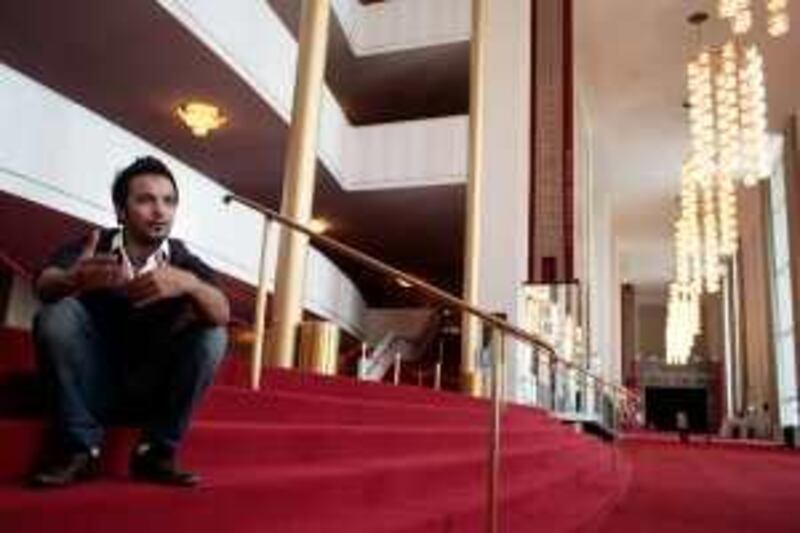WASHINGTON // America has finally met Um Saeed. And Um Allawi and Um Saloom and Um Khammas, the Emirati grandmothers whose exploits and misadventures have charmed TV viewers in the Gulf for three seasons - but, until now, have not been seen here. Mohammed Saeed Harib, director and creator of the 3D animated series Freej, personally introduced the four Ums on the big screen in Washington this week as part of a major Arab arts festival.
There they were, sipping coffee in a Dubai living room, chattering about the awful desert heat. There they were, scolding Um Saeed's mischievous grandson, Abood, before - and after - he wreaked havoc in the neighbourhood. There they were, riding the Tube and visiting Madame Tussauds wax museum on a visit to London. "I just gotta say, your movie was amazing!" a skinny boy, among several hundred students from local area high schools who came for one of two screenings, told Mr Harib during the question-and-answer session, wanting to know more about how the animation is done.
The US debut of Freej was apt enough, as the main characters were born - artistically, at least - while Mr Harib was a student at Northeastern University in Boston in the 1990s. A native of Dubai, he jokes that they all hold US passports. Before showing the students three Freej episodes from season two, Mr Harib explained how the characters grew out of a homework assignment in an introductory animation course.
He and his classmates, who hailed from various parts of the world, were asked to create a superhero representing his or her homeland. "That will be very easy for me; I come from the land of Aladdins and Ali Babas," he remembers thinking at the time. He started with a "typical" male Arab hero, an Aladdin type, as he describes it. His professor, who always said the first 19 sketches have to be tossed out, was less than impressed. So he took a different approach.
"I drew my grandmother," he said. The instructor, Mr Harib said, was blown away. He had come up with a female hero in a male-dominated society - a way for him to honour the role of older Emirati women who raised large families and underwent hardships of their own while their husbands were off doing more traditional work. Mr Harib had also endowed the new character - the one millions have come to know as Um Saeed - with a highly distinctive look.
For one, he had her wear a traditional burqa (his version of the superhero's traditional cape, he said). Mr Harib intended it, he said, as a way of "archiving who we are". But, as an artist, he also meant it to be mysterious and a bit provocative. "Any character that raises questions is a good character," he said in an interview after the screening. "I think characters should not be boring." Of the myriad American sitcoms on TV, Mr Harib admits being partial, in his formative years, to The Golden Girls.
Like his own cartoon, the show chronicles the lives of four elderly women (they live together in Miami). Mr Harib is also a fan of The Simpsons; any comparison between that programme and his is, in his view, most certainly a compliment. "I love The Simpsons," he said. "The Simpsons is a mirror to America. Like Freej ? Freej is a mirror to Arabia." Mr Harib, who will head to Las Vegas and New York as a tourist before returning to the UAE this month, was not quite sure how his cartoon would be received in the US - and, specifically, at Arabesque, a three-week celebration of Arab arts and culture at the Kennedy Center that ends on Sunday.
"I came here with very small expectations, because the show is very Arabic in its content and very Arabic in its jokes," he said. "But it goes to show there are many global human themes, like friendship. I think the main essence of the film is understood." "I liked the animation and the graphics," said Ahmed Afifi, 13, a student at a secondary school in Alexandria, Virginia, outside Washington, who came as part of his Arabic-language class.
He named Um Khammas, the voluble, rebellious grandmother whose three husbands each died mysteriously, as his favourite character. "She got mad easily, and she said funny things," he said. Zubair Baz, 16, liked Abood, Um Saeed's grandson, who is also known as Hyper Boy. "He demonstrated how some of the people act in my class," he said. Mr Harib is most protective of Um Saeed, as she is modelled after his own grandmother, who suffers from Alzheimer's disease and has no idea of her fame.
He hopes at some point to introduce her to millions more Americans, broadcasting the cartoon here, probably adapting the episodes so they are less tailored to an Arab audience. He just completed three new seasons of 15 episodes each. "She's the one who got the ball rolling," he said of Um Saeed, adding: "I'm happy to see all the four ladies get the spotlight." eniedowski@thenational.ae






